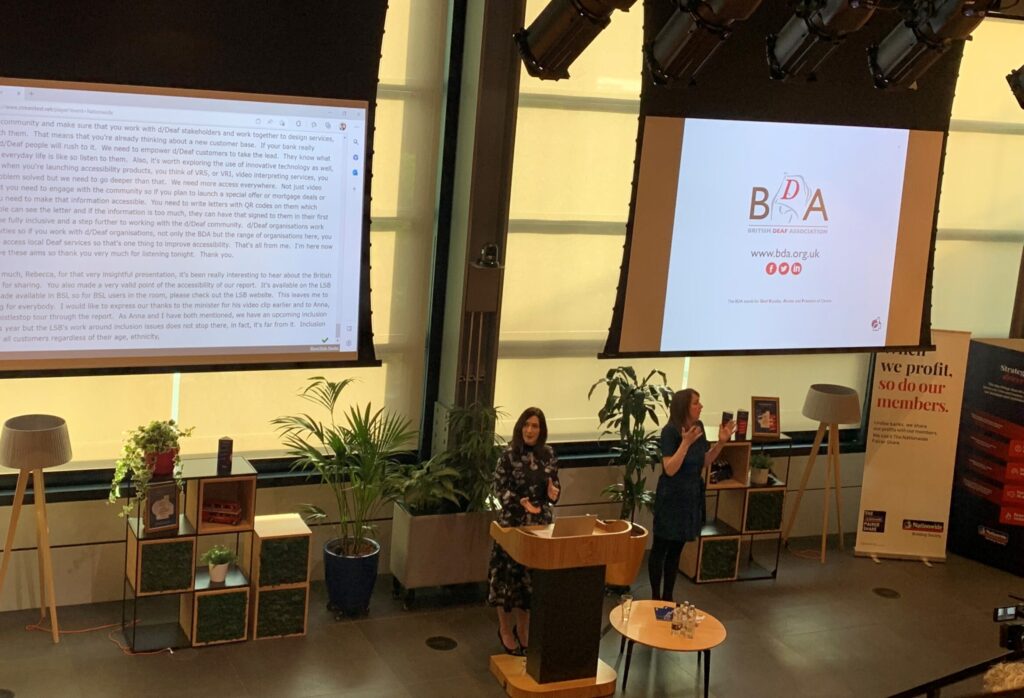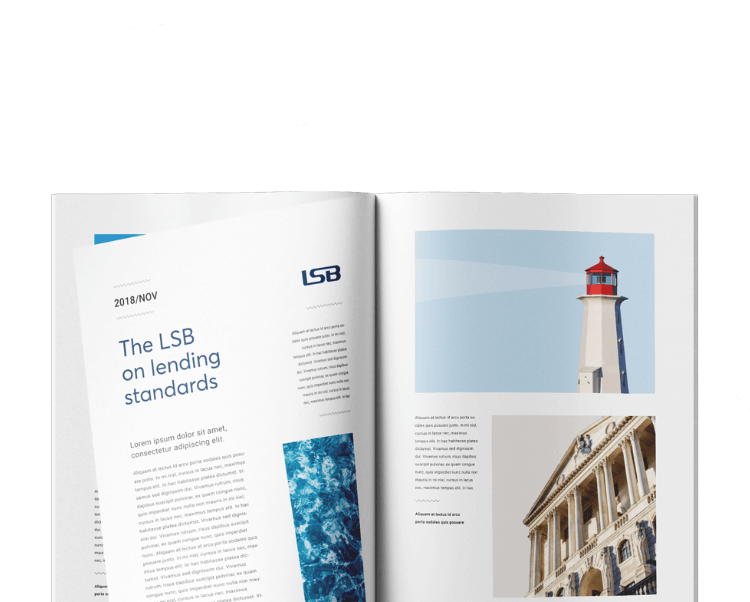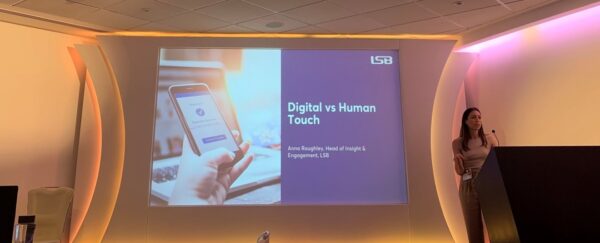We were delighted to launch our recent inclusion report ‘Access for d/Deaf customers in banking & credit’ with an event at Nationwide this week. The report provides insights on the challenges faced by this community and recommendations for promoting better access to financial services. During the event, we had a range of insightful speeches from our Chief Executive, Emma Lovell, Head of Insight & Engagement, Anna Roughley, CEO of the British Deaf Association, Rebecca Mansell, Kathryn Townsend, Head of Vulnerability at Nationwide, and Tom Pursglove MP, Minister of State for Disabled People, Health and Work.
You can read Emma and Anna’s speeches below, and view a copy of the report, also available in BSL, here.
Event speeches

*The notes below may differ from those delivered on the day*
I’m Emma Lovell, Chief Executive of the Lending Standards Board, the LSB, and I’m delighted to see so many of you here today as we launch our report on Access for little d/ large D Deaf customers in banking and credit. Some of you here today may be very familiar with our work, as I can see lots of familiar faces from registered firms and stakeholders, but for those who aren’t, I thought it may be useful to give you a whistle stop tour of the LSB and how we came to writing this report and holding this event.
For those who don’t know, the LSB is the primary self-regulatory body for the banking and lending industry. What that means is that we set and oversee best practice Standards and Codes that drive good outcomes for customers of financial services. These sit above statutory regulation or exist where there aren’t other protections in place for customers. Our Standards and Codes set the benchmark for good practice in the UK when it comes to banks, lenders and building societies – or firms as we’ll call them for ease – dealing with their customers. The protections they provide cover personal customers, business customers with a turnover of up to 25 million, and also provide much needed protections for customers from Authorised Push Payment scams.
Firms sign up to our Standards to evidence they want to do the best they can for their customers. As I said, I can see many familiar faces from our registered firms today, which is really great to see. For anyone here from a non-registered firm, please do feel free to come and chat to any of the LSB team afterwards – we’d be more than happy to answer any questions you might have about registration. We’d also be really keen to hear your own insights and experiences of what has worked well for your firms to further accessibility and financial inclusion. Collaboration is such a big driver for financial inclusion, and so we’ll have some time for networking at the end of our speeches, where I hope we can collaborate and share with one another.
Within our personal Standards, there is a key focus on financial inclusion – ensuring all customers, regardless of their life experience or circumstances, can access financial products and services to best suit their needs. In order to offer the right support, identifying customer’s needs is key, and that is where best practice guidance can be a vital tool. With external drivers like the cost-of-living crisis and pandemic evolving customer’s needs or creating additional challenges, the guidance available to firms should evolve too, to keep pace with this change. That’s one of the key benefits of being a self-regulatory body – we are in a position to drive forward areas such as inclusion and accessibility, by having the agility to act quickly, be flexible, and where additional guidance is needed, to provide that guidance to firms to raise industry standards and outcomes for customers. The report we are launching today is an example of this and is part of a series of inclusion work we are carrying out.
Last year, we produced a report looking at business banking for disabled customers and those with other access needs, and later in the year we’ll be writing a piece on how firms can better support ethnic minority business owners to access lending and banking and grow their businesses. The report we are launching today provides insights on the challenges faced by the deaf communities, and recommendations for promoting better access to financial services. We were incredibly lucky to interview a range of inspiring individuals and experts on this important topic, from charity representatives to experts by experience. Thank you all for the vital insights and experiences you shared with the team. Your contributions have been instrumental in creating this report, which will hopefully assist in breaking down barriers for customers in the Deaf community and those with hearing loss.
So on to today’s event. Unfortunately Tom Pursglove MP, Minister of State for Disabled People, Health and Work who wrote the foreword for the report is unable to be with us today, but he has recorded a short video for us in support of tonight’s event and report launch. After the video you will hear from our Head of Insight and Engagement, Anna Roughley, who will share key highlights from the report, and finally Rebecca Mansell, Chief Executive of The British Deaf Association.

*The notes below may differ from those delivered on the day*
I’m Anna Roughley, and I head up the LSB’s Insight team. The role of our team is to help firms embed the requirements of the LSB’s Standards and Codes through Insight, and we do this through a whole host of channels; training, roundtables, forums, thought pieces – the team have even got me onto podcasts – who knows what will come next!
Over the last few months, I’ve had the absolute privilege, alongside the team here today, of speaking to so many inspirational people from the Deaf communities who have shared their experiences with us for this piece of work. We have learnt so much about what financial inclusion and accessibility could look like, and how we, as an industry, can take greater steps to achieve this inclusivity.
I want to echo Emma’s thanks to you all – we really could not have created this report without your input and the support of you all here today both guests and interpreters. And actually, that’s the first part of a really important message I want to share with everyone here today.
As a regulator, our role is to drive high standards through setting and overseeing best practice guidance, but what’s clear from our work on inclusion, is that we cannot fulfil our mission without including the voices of lived experience experts in our work. And neither can you. Because, for all of us – banks, lenders, building societies, stakeholders – all organisations, unless you engage with people with lived experience, you will, without meaning to, make decisions on behalf of communities that may be wrong. Having people with lived experience contribute to the design and delivery of a product or service is therefore absolutely vital. We speak about this in more detail in our report which you’ll all now have a copy of. I hope this is something you’ll take away to digest, share with your teams, and use to help drive forwards financial inclusion for your customers. But before you get fully stuck in, I thought I’d share some of the key highlights in the report with you today.
I mentioned there about sharing this piece of work with your teams – so I’ll start by talking about why that is important – and that is to raise awareness amongst staff. This is a topic that can feel overwhelming sometimes. You might be sat there asking ‘how can we train someone on everything, Anna?’. And we get it – in the last few years especially there has been a lot of pressure on firms to provide tailored support to customers as their needs evolve. We know this isn’t easy, and that additional regulatory requirements can add pressure too. But awareness doesn’t mean having to be an expert in everything a customer may face, it’s just about having a general understanding of what challenges may crop up, and then how you can provide support, information, or signpost that person, if that is what is needed. One example we gave in the report of where staff awareness can help a customer feel heard, is through giving someone the time they need for an interaction with their firm. That is because some people with access needs may need more time than other customers, and so staff having an awareness and understanding of this can help that customer to feel listened to, have the space to share what they need, and to ultimately receive a better outcome as a result. I think we can say this is something everyone would benefit from actually.
Awareness and lived experience also feed into the next key insight I’d like to share, which is around the importance of getting customer interactions right, and not just presuming that they are right. For example, it was raised during the interviews we conducted that there is often a reliance on written English to communicate with Deaf customers, but this might not be as accessible as some of you may think. This is because some Deaf customers, for example, those who have been Deaf since birth, use BSL as their first language, not written English. I don’t actually mind admitting that something I learnt during this process, was that BSL is a language in its own right, and doesn’t actually translate to written English. Therefore, this may not be accessible to some, and just really hammers home that point about engaging with people with lived experience, to ensure things like this are considered before a product or process goes live.
Ensuring accessibility at all stages of a customer journey is crucial, from design, to delivery, to receiving feedback. What is your process for customer complaints, for example? Is that accessible? It was shared with us that often the complaints process can actually be inaccessible for some people in the Deaf community, and therefore complaints data may not paint an accurate picture of what is actually going on for your customers. Another reason why lived experience at the design stage of a project is really important.
Another topic we focussed on in our report was the use of third-parties – how many of the people we interviewed relied on friends and family members to support them in accessing banking services. Although this can be helpful, it also comes with many downsides; losing independence being a big factor for one. I’m sure you’ll agree that many of us don’t want to share our private banking detail with others, yet for many in the Deaf community, this is a necessity because the services available are not accessible. Another downside shared by a loved one of someone in the Deaf community, is the pressure that puts on the third-party person. Having to juggle your own ‘life admin’ shall we call it, with that of loved ones, could carry a lot of weight and responsibility. There’s also the issue of scams and fraud that come with sharing details with others. Details that have more of a chance to be intercepted and taken advantage of by criminals. By making simple changes, these risks can be mitigated, and all customers can get a fairer detail.
I’ve talked quite a bit here about the issues Deaf customers may face – but what are those simple steps firms can take to help break down the barriers and ensure inclusion for all? I’ve spoke about staff awareness and the importance of lived experience voices (as you can probably tell, I really can’t stress enough how important this is!). We also speak in the report about champions – colleagues who can represent customer groups, spread awareness, and drive best practice, as well as the importance of good training, and offering tailored support. I don’t want to give away too much before you have a chance to read this for yourselves, so I’ll leave it there for now.
I’m really proud of the whole team and all those involved for this report. As Emma mentioned, it’s part of a three-part inclusion series, so if you haven’t already, be sure to check out our first report on inclusion for disabled customers, and keep your eye out for the upcoming piece on access and inclusion for ethnic minority business customers.
Once again a big, big thank you to you all for being here. I really hope this report, alongside working together to share best practice and things that really work, will go a long way to supporting a vital community of customers get a better deal when it comes to accessing financial services.









